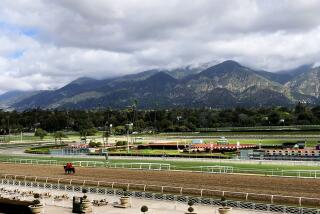NTSB issues safety recommendations for Reno air races
Federal investigators issued seven recommendations Tuesday to improve the safety of the National Championship Air Races in Reno, where a highly modified World War II fighter plane plunged into spectators last year and killed 11 people, including the pilot.
The National Transportation Safety Board called on the Reno Air Racing Assn. to review its 8.4-mile course to determine whether the risk to spectators could be reduced during races of powerful piston-engine aircraft in the so-called unlimited class. Many of them are rebuilt military planes, such as P-51 Mustangs, F8F Bearcats and F4U Corsairs, capable of exceeding 500 mph.
NTSB officials recommended pre-race inspections, testing and engineering evaluations to ensure that unlimited-class aircraft could withstand the stresses of high-speed competition.
They also called on the racing association to provide training and techniques so pilots could better cope with high gravitational forces that can incapacitate them. The pilot of the ill-fated plane is thought to have blacked out from exposure to extreme Gs.
Investigators further recommended safety barriers for spectator and pit areas and asked the Federal Aviation Administration to review its air race guidelines.
The distance between the crowd and the race course exceeded the FAA’s minimum requirement of 500 feet during the event, but NTSB officials wondered whether more distance might be necessary because of the race’s high speeds.
“We need to change the playing field so spectators and pilots are safer in the future,” said Deborah A.P. Hersman, chairwoman of the NTSB. “I am most concerned that change occurs prior to the next race in September. These recommendations are common sense and can be accomplished” before then.
The crash occurred on Sept. 16, when a highly modified P-51D Mustang named the Galloping Ghost went out of control, shot skyward, then rolled over and plummeted into a viewing area. The pilot and 10 spectators were killed, and at least 60 people were injured.
The probable cause has yet to be determined, but NTSB officials said the pilot probably lost control when an elevator trim tab broke on the aircraft’s tail. As the plane pitched up suddenly, veteran racer and stuntman Jimmy Leeward experienced at least 9 Gs of force in less than a second, causing him to either black out or become incapacitated. The plane then rolled over and dived into the crowd.
Hersman said the racing association did not require pre-race testing for aircraft that had been modified over time like the Galloping Ghost. She noted that, on the day of the crash, the plane and pilot were flying faster than they ever had, and experienced the most G-forces.
FAA officials said Tuesday that the agency revised its policies to require the Reno association and other air racing organizations to go through a standardized accreditation process for races. For this year’s competition in Reno, they said, the FAA will do a comprehensive review of the operation, including a close examination of the race course and the proposed spectator area.
“Safety is FAA’s top priority, and the agency continues to work closely with air race organizations and conduct thorough inspections to ensure compliance with FAA safety regulations,” officials said in a statement. “The FAA is already working to address the NTSB’s recommendation.”
Officials of the Reno Air Racing Assn. could not be reached for comment.
More to Read
Sign up for Essential California
The most important California stories and recommendations in your inbox every morning.
You may occasionally receive promotional content from the Los Angeles Times.











